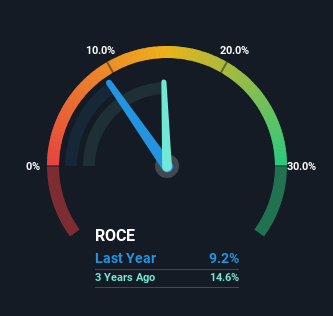- India
- /
- Auto Components
- /
- NSEI:MUNJALAU
Investors Will Want Munjal Auto Industries' (NSE:MUNJALAU) Growth In ROCE To Persist
If we want to find a stock that could multiply over the long term, what are the underlying trends we should look for? In a perfect world, we'd like to see a company investing more capital into its business and ideally the returns earned from that capital are also increasing. This shows us that it's a compounding machine, able to continually reinvest its earnings back into the business and generate higher returns. Speaking of which, we noticed some great changes in Munjal Auto Industries' (NSE:MUNJALAU) returns on capital, so let's have a look.
Understanding Return On Capital Employed (ROCE)
Just to clarify if you're unsure, ROCE is a metric for evaluating how much pre-tax income (in percentage terms) a company earns on the capital invested in its business. Analysts use this formula to calculate it for Munjal Auto Industries:
Return on Capital Employed = Earnings Before Interest and Tax (EBIT) ÷ (Total Assets - Current Liabilities)
0.092 = ₹591m ÷ (₹13b - ₹6.3b) (Based on the trailing twelve months to December 2024).
Therefore, Munjal Auto Industries has an ROCE of 9.2%. In absolute terms, that's a low return and it also under-performs the Auto Components industry average of 15%.
View our latest analysis for Munjal Auto Industries

While the past is not representative of the future, it can be helpful to know how a company has performed historically, which is why we have this chart above. If you'd like to look at how Munjal Auto Industries has performed in the past in other metrics, you can view this free graph of Munjal Auto Industries' past earnings, revenue and cash flow .
So How Is Munjal Auto Industries' ROCE Trending?
Even though ROCE is still low in absolute terms, it's good to see it's heading in the right direction. The data shows that returns on capital have increased substantially over the last five years to 9.2%. The amount of capital employed has increased too, by 59%. This can indicate that there's plenty of opportunities to invest capital internally and at ever higher rates, a combination that's common among multi-baggers.
On a side note, we noticed that the improvement in ROCE appears to be partly fueled by an increase in current liabilities. Effectively this means that suppliers or short-term creditors are now funding 50% of the business, which is more than it was five years ago. Given it's pretty high ratio, we'd remind investors that having current liabilities at those levels can bring about some risks in certain businesses.
In Conclusion...
A company that is growing its returns on capital and can consistently reinvest in itself is a highly sought after trait, and that's what Munjal Auto Industries has. And with a respectable 98% awarded to those who held the stock over the last five years, you could argue that these developments are starting to get the attention they deserve. In light of that, we think it's worth looking further into this stock because if Munjal Auto Industries can keep these trends up, it could have a bright future ahead.
On a final note, we've found 3 warning signs for Munjal Auto Industries that we think you should be aware of.
While Munjal Auto Industries isn't earning the highest return, check out this free list of companies that are earning high returns on equity with solid balance sheets.
New: Manage All Your Stock Portfolios in One Place
We've created the ultimate portfolio companion for stock investors, and it's free.
• Connect an unlimited number of Portfolios and see your total in one currency
• Be alerted to new Warning Signs or Risks via email or mobile
• Track the Fair Value of your stocks
Have feedback on this article? Concerned about the content? Get in touch with us directly. Alternatively, email editorial-team (at) simplywallst.com.
This article by Simply Wall St is general in nature. We provide commentary based on historical data and analyst forecasts only using an unbiased methodology and our articles are not intended to be financial advice. It does not constitute a recommendation to buy or sell any stock, and does not take account of your objectives, or your financial situation. We aim to bring you long-term focused analysis driven by fundamental data. Note that our analysis may not factor in the latest price-sensitive company announcements or qualitative material. Simply Wall St has no position in any stocks mentioned.
About NSEI:MUNJALAU
Munjal Auto Industries
Manufactures and sells auto components for motor vehicles in India.
Low risk and slightly overvalued.
Market Insights
Community Narratives



